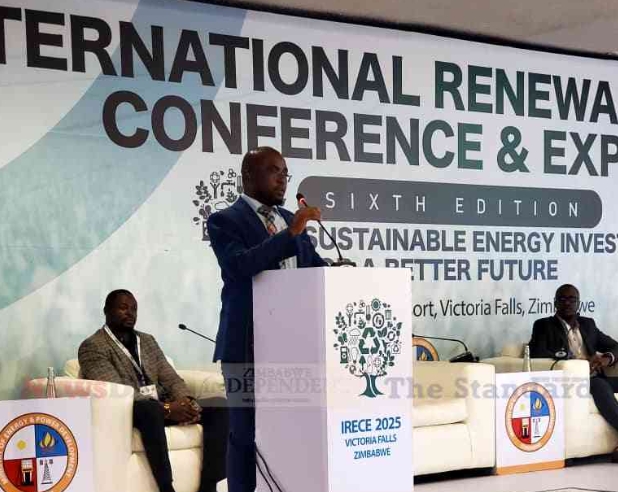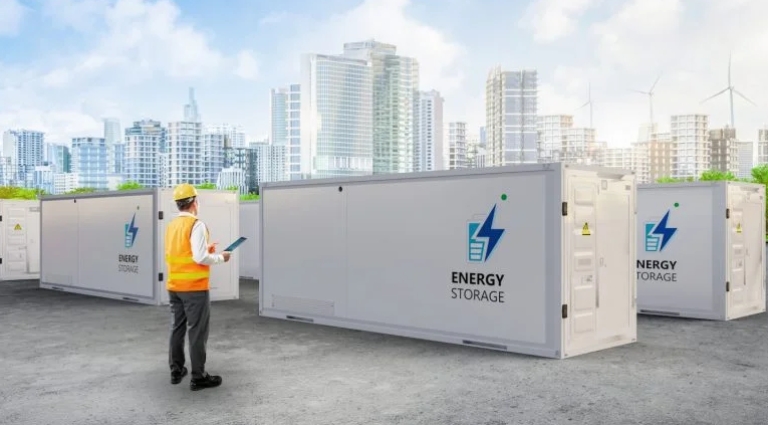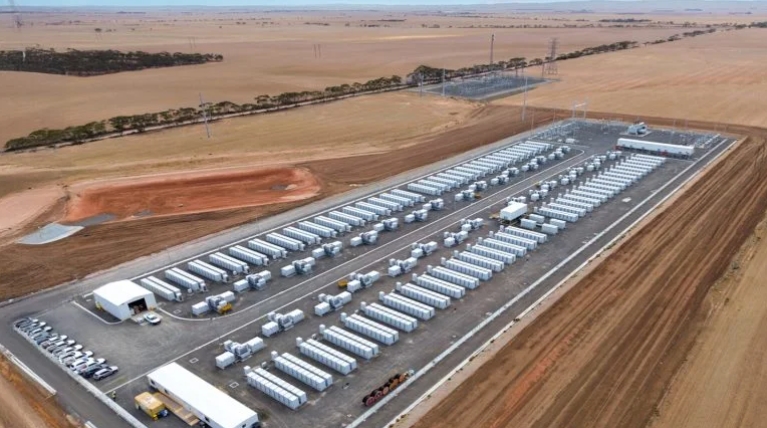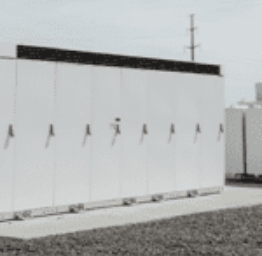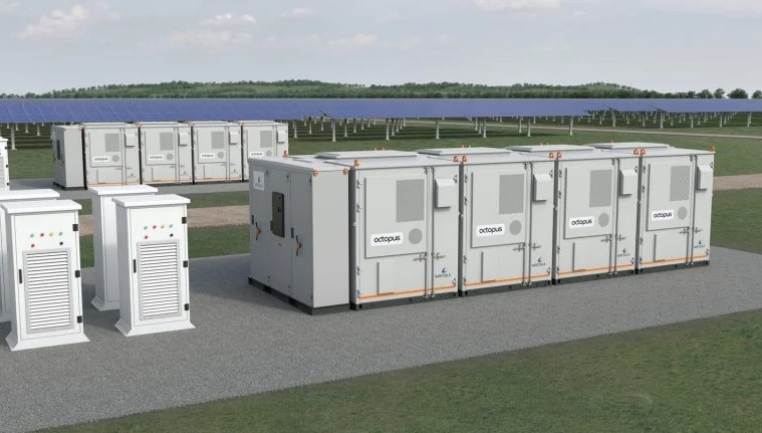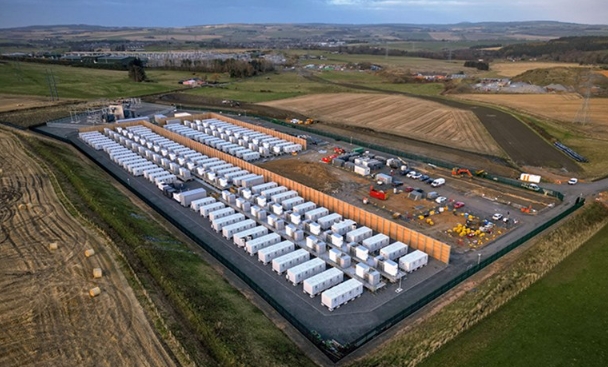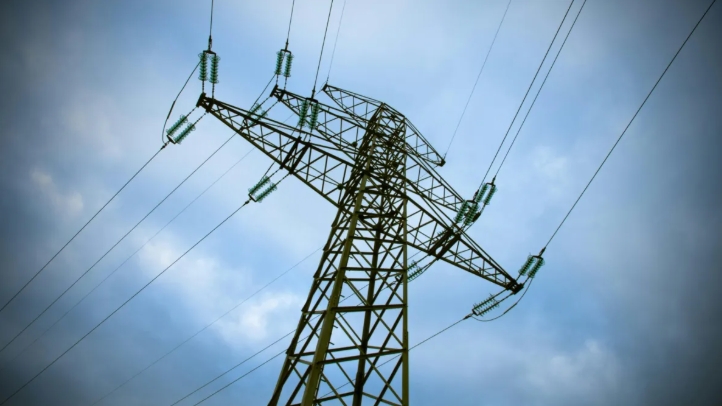This story was supported by the Pulitzer Center on Crisis Reporting.
THE FOUR Kachin Independence Army soldiers relax inside a large tent, drinking tea and smoking cigarettes.
Occasionally one of them gets up and walks to the edge of the clearing, peering out over a thin wall of bamboo and weeds into the valley below.
Barely 100 metres down the slope is a Tatmadaw camp. The tight cluster of brown huts sits in the shadow of a 50-metre-high wall for a hydropower project, Darpein 1, that effectively marks the front line of the conflict in this part of Momauk Township, Kachin State.
While the much larger hydropower projects further to the north, beyond the state capital Myitkyina, get most of the attention, it was here in June 2011 that a 17-year ceasefire between the Tatmadaw and the Kachin Independence Organisation broke down. To this day, both sides maintain the other was at fault.
From this remote, sparsely populated location, the conflict quickly spread across Kachin and northern Shan states. Within days, both sides were reinforcing the front lines; the KIA destroyed dozens of bridges in an effort to hamper Tatmadaw troop movements, including one over the Nam Hpak Kha River on the road leading to the Darpein dam site.
Today, more than 100,000 civilians are displaced; nearly all remain in IDP camps. The front lines are littered with land mines. Negotiations towards a ceasefire have at times seemed to make progress, but the conflict remains officially active. Fighting could resume at any time.
What role did hydropower projects like Darpein play in provoking the conflict?
‘Full of happiness’
When contractor Sinohydro, a Chinese state-owned firm, began work at Darpein in December 2007, the company issued a flowery statement describing locals dressed in traditional costumes, dancing to the beat of drums. “The mood is full of happiness,” the company observed.
Behind the scenes, though, not everyone was happy – least of all the Kachin Independence Organisation, which was not consulted on the Darpein projects and insists the dams are inside territory it has controlled for decades.
Darpein was one of several dozen hydropower projects that Chinese investors – mostly state-owned companies – negotiated with the military regime in the mid-2000s. Many were in conflict-affected areas of Kachin, Shan and Kayin states. Communities and other stakeholders, such as armed groups and civil society, were excluded from the negotiation process, which at the insistence of the junta took place behind closed doors.
The KIO and Kachin civil society groups had long warned that large infrastructure projects implemented without consultation could lead to a resumption of conflict. Aside from the environmental and social effects, they have accused the Tatmadaw of using the hydropower and other infrastructure projects as a pretext to expand its territory and increase militarisation in northern Myanmar. Most of these projects stalled in the early stages of development.
But at Darpein 1, the junta and its investment partners pressed on. “I would say the Darpein project is a living example of the issues civil society has been raising for decades on the social impacts of dams planned in conflict-prone areas in remote ethnic states of Myanmar,” said Ms Pianporn Deetes, International Rivers’ campaigns director for Thailand and Myanmar.
Some though have described it as an oversimplification to blame Chinese investment for the conflict, given that tension had been rising over the Tatmadaw’s plan to have the KIO transform into a Border Guard Force.
“Chinese dams in Kachin state are not the reason the truce fell apart,” Ms Yun Sun, a senior associate at the Henry L Stimson Center, a Washington-based global security think-tank, wrote in July 2011. “Although they have aggravated hostility between Nay Pyi Taw and the KIA, they have mostly been used for strategic leverage by both sides to advance their positions.”
Veteran journalist Mr Bertil Lintner echoed this view, saying that the conflict was due to Tatmadaw anger at the KIO’s refusal to become a Border Guard Force.
KIO officials were reluctant to discuss the projects when Frontier visited Laiza in March.
Insisting that the conflict was not due to the hydropower projects, the group’s spokesperson Colonel Naw Bu said, “This is a political game. We will not criticise the Chinese government or Chinese investment. We will stand as neutral.”
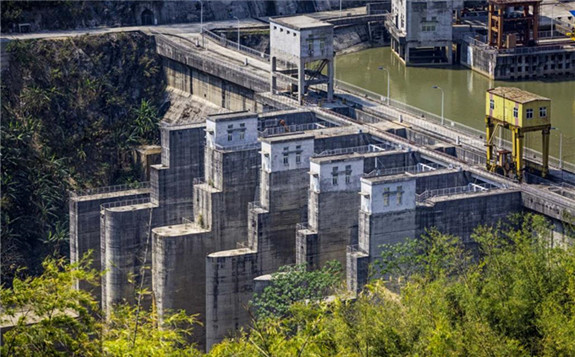 The Darpein dam, seen from a Kachin Independence Army position in Momauk Township, Kachin State. (Hkun Lat | Frontier)
The Darpein dam, seen from a Kachin Independence Army position in Momauk Township, Kachin State. (Hkun Lat | Frontier) The Darpein dam, seen from a Kachin Independence Army position in Momauk Township, Kachin State. (Hkun Lat | Frontier)Money talks
The confrontations before and after the opening of the Darpein 1 project appear to be related to contractual terms and payments rather than concerns over territorial expansion or environmental and social impacts.
A 2016 paper published in the peer-reviewed journal Water on hydropower development in Yunnan Province stated that the Kachin were upset at the “extremely poor contractual terms” for Darpein 1, and this was one of the factors in the breakdown of the ceasefire.
Tensions date back to the very beginning of the project. When the “Chinese authorities” refused to pay taxes to the KIO, the group began deploying soldiers around the two Darpein dam sites in September 2008, The Irrawaddy reported at the time. Chinese workers immediately fled the site and construction ground to a halt, the report said.
They returned only after the Chinese paid 1.5 million yuan ($277,000) to the KIO. The following February, tensions ratcheted up when the Tatmadaw was accused of destroying a KIO outpost beside the Darpein dam. The post was later rebuilt following talks in the state capital, Myitkyina.
More payments were also to follow in an effort to satisfy the KIO, although the exact details are hard to pin down. Environmental group International Rivers says the developer of Darpein 1, state-owned China Datang Corporation, paid an extra 20 million yuan ($3.7 million) to the KIO when the armed group threatened Chinese workers. The company described the payment as an environmental tax, International Rivers says.
Citing conversations with senior KIO leaders, Mr Matthew Smith of human rights group Fortify Rights wrote in the New York Times in 2015 that China Datang paid the KIO $2.4 million in 2011 order to move ahead with Darpein 1. China Datang also agreed to a demand to divert some electricity to KIO territory, but refused to make it official with a contract, Smith wrote. Fighting broke out at Darpein 1 shortly afterwards.
This payment was even referred to by Minister for Information U Kyaw Hsan at a press conference in August 2011, when he said: “We have heard that the Chinese company secretly paid 15 million yuan to the KIO to implement the project smoothly without obstacles.”
On the surface, these payments appear to have worked. According to the Ministry of Electricity and Energy, the hydropower plant is operating as normal. China Southern Power Grid says on its website that from August 26, 2008, to December 31, 2015, it bought 12.471 billion kWh from the Shweli-1 and Darpein-1 projects. But ministry figures and sources paint a different picture.
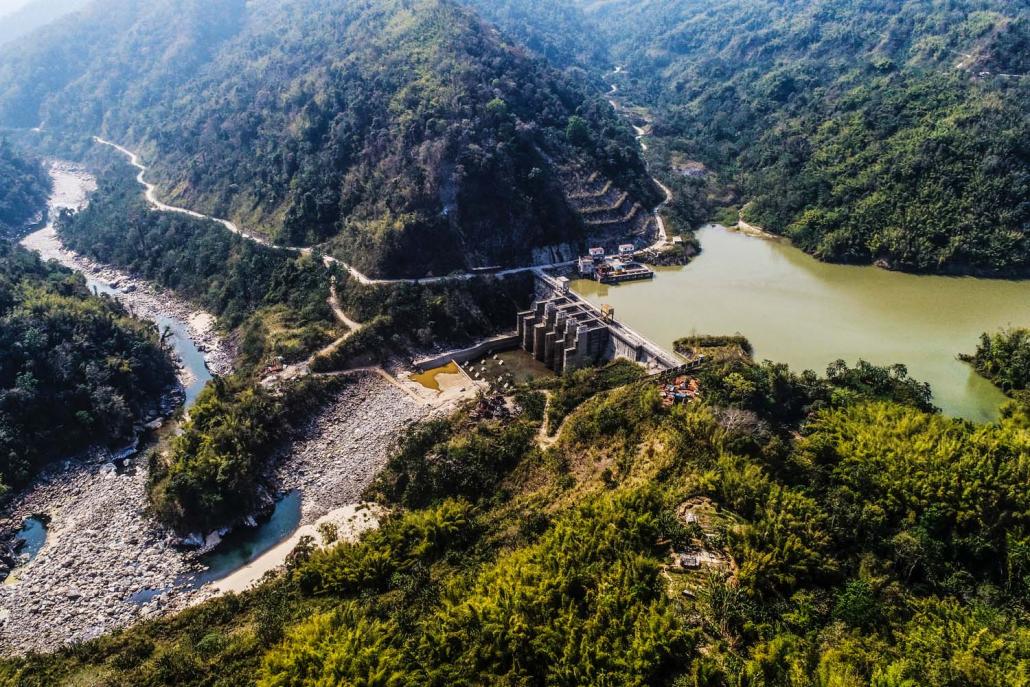 Hkun Lat | Frontier
Hkun Lat | Frontier A tributary of the Ayeyarwady, the Darpein River (Ta Hkaw Hka in Kachin and Daying in Chinese) is only 246 kilometres long but has estimated hydropower potential of 2.6 gigawatts, nearly all of which has been developed on the Chinese side of the border.
Darpein 1 was one of two hydropower projects on the Darpein River in Myanmar that Datang (Yunnan) United Hydropower Developing Co Ltd, a subsidiary of state-owned China Datang Corporation, planned to develop in partnership with the Ministry of Electricity and Energy.
Under the terms of the original agreement, Myanmar was to receive around 8 percent of the power produced from the 240-megawatt project for free, and the rest would be either exported to China via a 500kV transmission line or distributed to the grid in Myanmar.
Further downriver, Darpein 2, also a joint venture, would have 140MW of installed capacity and produce power exclusively for domestic use, according to Ministry of Electricity of Energy. A memorandum of understanding for the project was signed in 2008, but work does not appear to have ever started.
With only a small reservoir, work on Darpein 1 proceeded relatively quickly. Construction was contracted to state-owned Sinohydro and got underway in December 2007.
In September 2010, Datang announced the plant had gone into operation. According to information services group Interfax, the company said it planned to boost the installed capacity of the RMB1.7 billion ($250 million) plant to 400MW in the future – an apparent reference to the full cascade, including Darpein 2. The report said the company would operate the plant for 40 years under a build-operate-transfer contract before transferring it to the Myanmar government. An official opening was held in January 2011.
But production stopped just a few months later. Shortly afterwards fighting erupted at the same site between the Tatmadaw and KIA.
Production later resumed, but at significantly reduced capacity, according to ministry sources and a 2017 report by US consulting firm Delphos International that was based on figures from the Ministry of Electricity and Energy. The report noted that just 90MW of installed capacity was “available” at Darpein 1, and from 2013 to 2016 the annual recorded output of Darpein 1 averaged around 30 gigawatt hours – just a few percent of its potential.
The key issue is a massive oversupply of hydropower capacity in Yunnan Province. From 2005 to 2014, its province-level installed capacity grew from 13.3GW to 57.9GW – the majority of it hydropower. During rainy season the oversupply is so acute that generators have to be shut down or idled because the grid is incapable of transmitting all the power, according to the 2016 paper published in Water. Wholesale prices are much lower than in other parts of China.
While Myanmar is suffering from power shortages, it doesn’t have the transmission capacity in place to send power from Darpein 1 to where it’s needed. The project connects to nearby Bhamo, but from there the only link to the national grid is a long 66kV line that is unsuitable for transmitting large quantities of electricity.
The Ministry of Electricity and Energy has a tentative plan to take 394GWh annually from Darpein 1 from 2021, according to the Delphos report, but it is unclear whether there has been any progress adding transmission capacity.
China Datang Corporation did not respond to a request for comment.
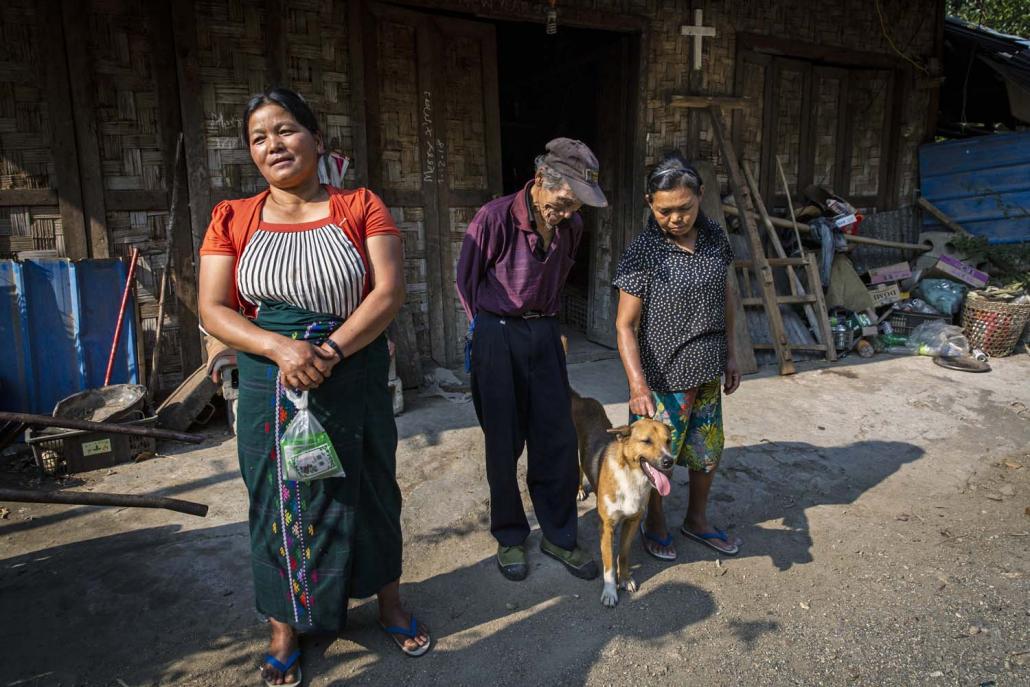 Local residents explained that the village had been home to around 100 people before the conflict, but most had fled to Bhamo and Momauk in 2011 to escape the fighting. (Hkun Lat | Frontier)
Local residents explained that the village had been home to around 100 people before the conflict, but most had fled to Bhamo and Momauk in 2011 to escape the fighting. (Hkun Lat | Frontier) Local residents explained that the village had been home to around 100 people before the conflict, but most had fled to Bhamo and Momauk in 2011 to escape the fighting. (Hkun Lat | Frontier)A tale of two hydro projects
Frontier visited the Darpein dam from Laiza, the headquarters of the KIO. The two-hour trip follows an earthen road that is only passable in a four-wheel drive.
The road snakes south along the Mong Lai Creek, which marks the border with China, until the creek runs into the Darpein River, forming a triangular frontier.
After crossing the Darpein River, the road forks at a sign warning of the presence of landmines. A kilometre or so to the south is Darpein 1 and the KIA outpost. To the northeast the road follows the Darpein River for another kilometre to U Mar Kar Zup village, which sits inside KIO territory.
A cluster of a few dozen homes beside the river, the village appeared almost deserted when Frontier drove in. After a while, a few residents approached warily, speaking only in Jinghpaw and asking who we were, with more than a hint of suspicion.
Later, they explained that the village had been home to around 100 people before the conflict, but most had fled to Bhamo and Momauk in 2011 to escape the fighting. Around 30 had since returned, living among the abandoned homes of their former neighbours.
On the opposite bank of the Darpein River, on Chinese soil, was a large pink building.
It didn’t look much like a hydropower plant – there was no reservoir – but it’s known as the Daying 4 hydropower station. According to the paper published by Water, the plant opened in 2009 and has an installed capacity of 875MW. A 220kV transmission line trailed over the hills behind it.
To generate power, water from the Darpein River is fed through a 17km diversion tunnel that runs through the mountains and emerges opposite U Mar Kar Zup.
A private Chinese company, Duoyuan, developed Daying 4 after reaching an agreement with the KIO, but without Myanmar government approval. The diversion means that upstream from Daying 4, the once-mighty Darpein River – which marks the national border – is often little more than a dried out creek-bed.
When Frontier asked about the two projects, resident Htaw Dao Awng said villagers bought power from Daying 4. But the price was high – around K200 a unit, nearly six times higher than the base Myanmar tariff.
“We can barely afford it. What we really want is just to get power from the Kachin government,” she said, referring to the KIO, “or the Myanmar government.”
Less than three kilometres downstream, the KIA soldiers were still relaxing in their tent, occasionally getting up to scan the calm waters of the Darpein 1 reservoir and the Tatmadaw camp nearby.
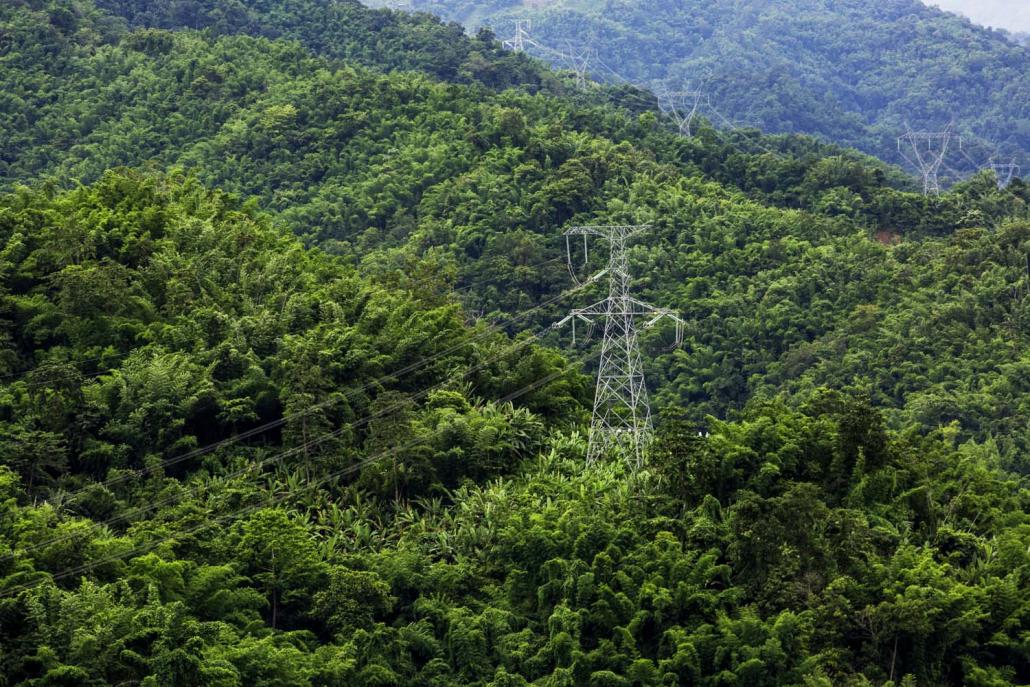 Transmission towers on the China side of the Darpein dam. (Hkun Lat | Frontier)
Transmission towers on the China side of the Darpein dam. (Hkun Lat | Frontier) Transmission towers on the China side of the Darpein dam. (Hkun Lat | Frontier)A war of words and bullets
The Tatmadaw and KIA have given significantly different accounts of how fighting erupted at Darpein in 2011, sparking a conflict that continues today.
The Tatmadaw alleges that on June 8 KIA soldiers near the dam detained a “member of a Tatmadaw security unit”, as well as two Tatmadaw officers who later tried to negotiate for the release of the detainee. According to state media reports from the time, the KIA then opened fire on a Tatmadaw column on June 9, marking the official resumption of hostilities. The Tatmadaw ordered the KIA to withdraw by June 11. When the group refused, the “Tatmadaw column inevitably attacked and occupied the temporary camp on 12 June evening,” the New Light of Myanmar reported at the time.
The fighting trapped hundreds of Chinese workers at the site for nearly a week. By June 14, the last of the 215 workers had been evacuated. “The only objective of the Tatmadaw in launching attacks on KIA is just to protect its members and an important hydropower project of the nation without even a single intention of aggression or oppression,” the New Light of Myanmar said.
But the KIA’s Information Department later insisted that it detained a policeman and two Tatmadaw officers because they trespassed on its territory. The Tatmadaw then attacked its outpost near the dam in the early hours of June 9, the KIA said, and captured one of its officers. Although the KIA withdrew, the Tatmadaw continued to attack. Later in the day, they agreed to exchange prisoners.
The captured KIA officer died that evening from his injuries, but the KIA still released the Tatmadaw detainees, it said. The Tatmadaw then reinforced its troops, before issuing an ultimatum that the KIA withdraw. When the Kachin group refused, Kachin State was once again at war.

